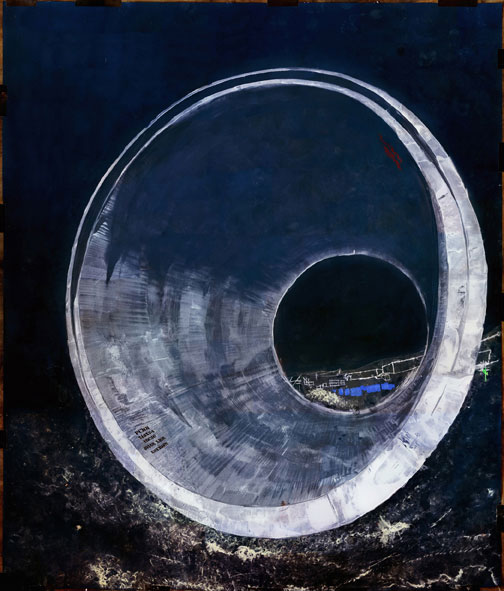Kelly Barrie’s hybrid process at first seems antithetical to photography and its ability to stop time, yet it is through his improvisations—like the nimbleness required by a skater or graffiti writer—that his work ingeniously engages a series of paradoxes. Rather than photograph reality, Barrie re-imagines the past as performative drawings, making elusive photographic prints that seem to transcend time and space while simultaneously being of the moment.
While not a skater per se, Barrie is as mired in skateboard culture as he is in art history and fuses these divergent attitudes. His outdoor sculpture Skate/Wave, circa 1978 (2013) is a social work in the tradition of relational aesthetics. A functional recreation of a skateboard ramp called the Wave that was moved from location to location in the 1970s, the artist’s ramp was used by local skaters during the opening.
Barrie’s photographs are mysterious. Most feature a luminous shape or object against a dark ground or receding into an ambiguous void. High and Dry, circa 1977 (2012) is a large light jet print that at first appears to be a photograph at night or a negative of a huge cylindrical pipe reminiscent of those placed in the desert in the 1970s as part of the Central Arizona Project (C.A.P.), which diverted water from the Colorado River via a series of canals. The pipes became destinations for skateboarders who frequented the various construction sites. Images of the pipes taken by skateboarders are reminiscent of documentation of Nancy Holt’s Sun Tunnels created in 1976 in Lucin, Utah. Holt and the skateboarders both delight in how light passes through the pipes and the dramatic shadows that often funnel into voids.
But High and Dry, circa 1977 was created in the studio, not in situ. Barrie’s works are the result of a private performance. In his studio he uses luminescent powder often drawing with his feet or with photographic squeegees. The works are process-intensive and grow over time: marks are made, dust accumulates, footprints appear, light changes. Each step along the way is photographed and composited. Working both large and small, Barrie has refined his process so that each drawing is reproduced to scale. The large works like High and Dry, circa 1977 and Down Hill, circa 1978 (2013), which details the markings and textures of a pipe’s interior, are created on his studio floor whereas the smaller pieces are created on table tops and often include traces of pieces of film, rings from coffee cups and other everyday detritus.
The works in “High and Dry” (also the name of his exhibition) follow Barrie’s past works exploring the aftermath of Hurricane Katrina. In Mirror House (2010) he began with a press photo of a tree and a house submerged in water, transforming it into a haunting image that captured the disorientation after the storm. For this, as well as other projects like his “Name Trees,” of famous trees documented, but no longer existing, Barrie draws on collective memory to make meaning, suggesting new ways for history to be visualized.


